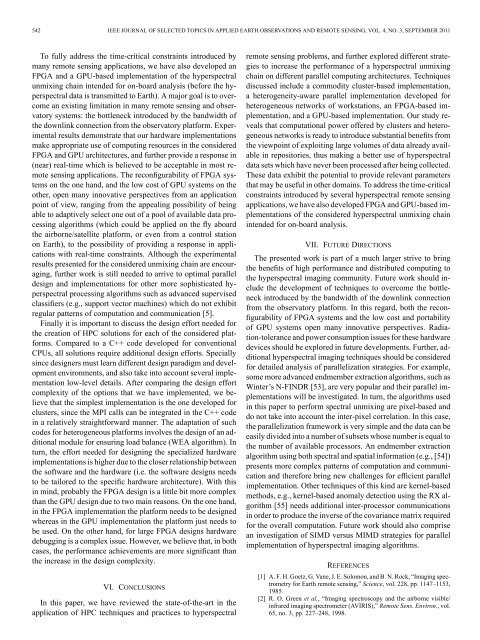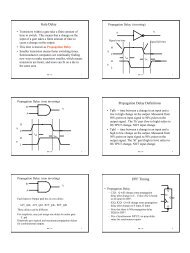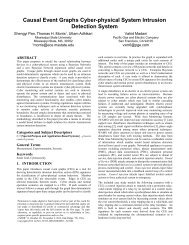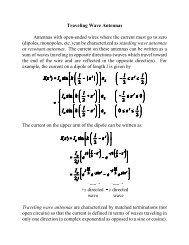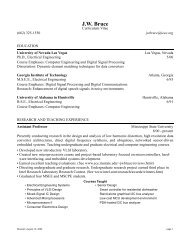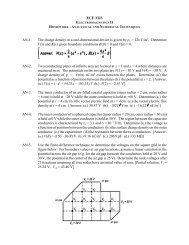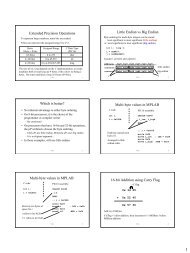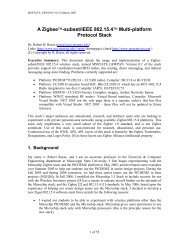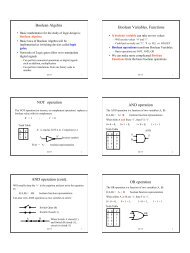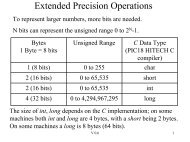High Performance Computing for Hyperspectral ... - IEEE Xplore
High Performance Computing for Hyperspectral ... - IEEE Xplore
High Performance Computing for Hyperspectral ... - IEEE Xplore
You also want an ePaper? Increase the reach of your titles
YUMPU automatically turns print PDFs into web optimized ePapers that Google loves.
542 <strong>IEEE</strong> JOURNAL OF SELECTED TOPICS IN APPLIED EARTH OBSERVATIONS AND REMOTE SENSING, VOL. 4, NO. 3, SEPTEMBER 2011<br />
To fully address the time-critical constraints introduced by<br />
many remote sensing applications, we have also developed an<br />
FPGA and a GPU-based implementation of the hyperspectral<br />
unmixing chain intended <strong>for</strong> on-board analysis (be<strong>for</strong>e the hyperspectral<br />
data is transmitted to Earth). A major goal is to overcome<br />
an existing limitation in many remote sensing and observatory<br />
systems: the bottleneck introduced by the bandwidth of<br />
the downlink connection from the observatory plat<strong>for</strong>m. Experimental<br />
results demonstrate that our hardware implementations<br />
make appropriate use of computing resources in the considered<br />
FPGA and GPU architectures, and further provide a response in<br />
(near) real-time which is believed to be acceptable in mostremote<br />
sensing applications. The reconfigurability of FPGA systems<br />
on the one hand, and the low cost of GPU systems on the<br />
other, open many innovative perspectives from an application<br />
point of view, ranging from the appealing possibility of being<br />
able to adaptively select one out of a pool of available data processing<br />
algorithms (which could be applied on the fly aboard<br />
the airborne/satellite plat<strong>for</strong>m, or even from a control station<br />
on Earth), to the possibility of providing a response in applications<br />
with real-time constraints. Although the experimental<br />
results presented <strong>for</strong> the considered unmixing chain are encouraging,<br />
further work is still needed to arrive to optimal parallel<br />
design and implementations <strong>for</strong> other more sophisticated hyperspectral<br />
processing algorithms such as advanced supervised<br />
classifiers (e.g., support vector machines) which do not exhibit<br />
regular patterns of computation and communication [5].<br />
Finally it is important to discuss the design ef<strong>for</strong>t needed <strong>for</strong><br />
the creation of HPC solutions <strong>for</strong> each of the considered plat<strong>for</strong>ms.<br />
Compared to a C++ code developed <strong>for</strong> conventional<br />
CPUs, all solutions require additional design ef<strong>for</strong>ts. Specially<br />
since designers must learn different design paradigm and development<br />
environments, and also take into account several implementation<br />
low-level details. After comparing the design ef<strong>for</strong>t<br />
complexity of the options that we have implemented, we believe<br />
that the simplest implementation is the one developed <strong>for</strong><br />
clusters, since the MPI calls can be integrated in the C++ code<br />
in a relatively straight<strong>for</strong>ward manner. The adaptation of such<br />
codes <strong>for</strong> heterogeneous plat<strong>for</strong>ms involves the design of an additional<br />
module <strong>for</strong> ensuring load balance (WEA algorithm). In<br />
turn, the ef<strong>for</strong>t needed <strong>for</strong> designing the specialized hardware<br />
implementations is higher due to the closer relationship between<br />
the software and the hardware (i.e. the software designs needs<br />
to be tailored to the specific hardware architecture). With this<br />
in mind, probably the FPGA design is a little bit more complex<br />
than the GPU design due to two main reasons. On the one hand,<br />
in the FPGA implementation the plat<strong>for</strong>m needs to be designed<br />
whereas in the GPU implementation the plat<strong>for</strong>m just needs to<br />
be used. On the other hand, <strong>for</strong> large FPGA designs hardware<br />
debugging is a complex issue. However, we believe that, in both<br />
cases, the per<strong>for</strong>mance achievements are more significant than<br />
the increase in the design complexity.<br />
VI. CONCLUSIONS<br />
In this paper, we have reviewed the state-of-the-art in the<br />
application of HPC techniques and practices to hyperspectral<br />
remote sensing problems, and further explored different strategies<br />
to increase the per<strong>for</strong>mance of a hyperspectral unmixing<br />
chain on different parallel computing architectures. Techniques<br />
discussed include a commodity cluster-based implementation,<br />
a heterogeneity-aware parallel implementation developed <strong>for</strong><br />
heterogeneous networks of workstations, an FPGA-based implementation,<br />
and a GPU-based implementation. Our study reveals<br />
that computational power offered by clusters and heterogeneous<br />
networks is ready to introduce substantial benefitsfrom<br />
the viewpoint of exploiting large volumes of data already available<br />
in repositories, thus making a better use of hyperspectral<br />
data sets which have never been processed after being collected.<br />
These data exhibit the potential to provide relevant parameters<br />
that may be useful in other domains. To address the time-critical<br />
constraints introduced by several hyperspectral remote sensing<br />
applications, we have also developed FPGA and GPU-based implementations<br />
of the considered hyperspectral unmixing chain<br />
intended <strong>for</strong> on-board analysis.<br />
VII. FUTURE DIRECTIONS<br />
The presented work is part of a much larger strive to bring<br />
the benefits of high per<strong>for</strong>mance and distributed computing to<br />
the hyperspectral imaging community. Future work should include<br />
the development of techniques to overcome the bottleneck<br />
introduced by the bandwidth of the downlink connection<br />
from the observatory plat<strong>for</strong>m. In this regard, both the reconfigurability<br />
of FPGA systems and the low cost and portability<br />
of GPU systems open many innovative perspectives. Radiation-tolerance<br />
and power consumption issues <strong>for</strong> these hardware<br />
devices should be explored in future developments. Further, additional<br />
hyperspectral imaging techniques should be considered<br />
<strong>for</strong> detailed analysis of parallelization strategies. For example,<br />
some more advanced endmember extraction algorithms, such as<br />
Winter’s N-FINDR [53], are very popular and their parallel implementations<br />
will be investigated. In turn, the algorithms used<br />
in this paper to per<strong>for</strong>m spectral unmixing are pixel-based and<br />
do not take into account the inter-pixel correlation. In this case,<br />
the parallelization framework is very simple and the data can be<br />
easily divided into a number of subsets whose number is equal to<br />
the number of available processors. An endmember extraction<br />
algorithm using both spectral and spatial in<strong>for</strong>mation (e.g., [54])<br />
presents more complex patterns of computation and communication<br />
and there<strong>for</strong>e bring new challenges <strong>for</strong> efficient parallel<br />
implementation. Other techniques of this kind are kernel-based<br />
methods, e.g., kernel-based anomaly detection using the RX algorithm<br />
[55] needs additional inter-processor communications<br />
in order to produce the inverse of the covariance matrix required<br />
<strong>for</strong> the overall computation. Future work should also comprise<br />
an investigation of SIMD versus MIMD strategies <strong>for</strong> parallel<br />
implementation of hyperspectral imaging algorithms.<br />
REFERENCES<br />
[1] A.F.H.Goetz,G.Vane,J.E.Solomon,andB.N.Rock,“Imagingspectrometry<br />
<strong>for</strong> Earth remote sensing,” Science, vol. 228, pp. 1147–1153,<br />
1985.<br />
[2] R.O.Greenet al., “Imaging spectroscopy and the airborne visible/<br />
infrared imaging spectrometer (AVIRIS),” Remote Sens. Environ., vol.<br />
65, no. 3, pp. 227–248, 1998.


